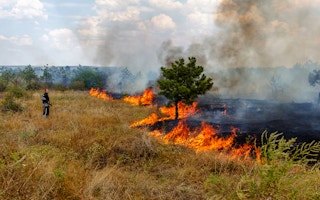What we know about climate change is bad. What we don’t know makes it potentially much worse. But climate change isn’t the only big problem facing society.
Opinions differ on what should rightly be called an “existential risk” or planetary-scale “catastrophe.” Some include nuclear accidents or terrorism. Others insist only nuclear war, or at least a large-scale nuclear attack, reaches dimensions worthy of the “global” label.
There are half a dozen other candidates that seem to make it on various lists of the worst of the worst, and it’s tough to come up with a clear order of which most demands our attention and limited resources. In addition to climate change, let’s consider asteroids, biotechnology, nanotechnology, nukes, pandemics, robots and “strangelets,” strange matter with the potential of swallowing the Earth in a fraction of a second.
That might strike some as a rather short list. Aren’t there thousands of potential risks? One could imagine countless ways to die in a traffic accident alone. That’s surely the case. But there’s an important difference: While traffic deaths are tragic on an individual level, they are hardly catastrophic as a class.
Every entry on our list has the potential to wipe out civilization as we know it. All are global, highly impactful and mostly irreversible in human timescales. Most are highly uncertain.
One response to any list like this is to say that each such problem deserves our (appropriate) attention, independently of what we do with any of the others. If there’s more than one existential risk facing the planet, we ought to consider and address each in turn.
That logic has its limits. If catastrophe policies were to eat up all the resources we have, we’d clearly have to pick and choose. But we don’t seem to be anywhere close. A first step, then, should always be to turn to benefit-cost analysis, which in turn is something that every U.S. president since Ronald Reagan has affirmed as a guiding principle of government policy.
Ideally, society should conduct serious benefit-cost analyses for each worst-case scenario: estimate probabilities and possible impacts, multiply the two, and compare it to the costs of action in each instance. If climate change and asteroids and biotechnology and nanotechnology and nukes and pandemics and robots and strangelets emerge as problems worthy of more of our attention, society should devote more resources to each.
But we can’t just hide behind standard benefit-cost analysis that ignores extremes. Each of these scenarios may also have their own variant of “fat tails,” or underestimated and possibly unquantifiable extreme events that could dwarf all else. The analysis soon moves toward some version of a precautionary principle focused on extreme events. The further we move away from standard benefit-cost analysis, the more acute the need to compare across worst-case scenarios — a comparison that is getting increasingly difficult.
How, then, to analyze these potential worst-case scenarios and decide which deserves more of our attention?
For one, only two on the list — asteroids and climate change — allow us to point to history as evidence of the enormity of the problem. For asteroids, go back 65 million years to the one that wiped out the dinosaurs. For climate, go back a bit over 3 million years to find today’s concentrations of carbon dioxide in the atmosphere and sea levels up to 20 meters (66 feet) higher than today.
Asteroids come in various shapes and sizes. We begin our book Climate Shock by looking at the one that exploded above Chelyabinsk Oblast in February 2013. The impact injured 1,500 and caused some limited damage to buildings. We shouldn’t wish for more of these impacts to happen just for the spectacular footage, but we’d be hard pressed to call an asteroid of that size a “worst-case scenario.”
NASA’s attempts at cataloguing and defending against objects from space aims at much larger asteroids, the ones that come in civilization-destroying sizes. Astronomers may have been underestimating the likelihood of Chelyabinsk Oblast–size asteroids all along. That’s a problem that needs to be rectified, but it’s not a problem that will wipe out civilization. If we estimated the likelihood of a much larger impact incorrectly, the consequences could be significantly more painful.
Luckily, when it comes to asteroids, there’s another feature working for us. Science should be able to observe, catalog and divert every last one of these large asteroids — if sufficient resources are provided. That’s a big if, but not an insurmountable one: A National Academy study puts the cost at $2 to $3 billion and 10 years’ research to launch an actual test of an asteroid deflection technology. That’s much more than we are spending at the moment, but the decision seems rather easy: Spend the money, solve the problem, move on.
Strangelets are the opposite of the Chelyabinsk Oblast asteroid in that they have never been observed. They are straight out of science fiction and may be theoretically impossible. If it is possible, though, there may be a chance that large heavy-ion colliders like the one ramping up once again at CERN near Geneva could create them. That has prompted research teams to calculate the likelihood of a strangelet actually happening. Their verdict: Concrete numbers for the upper bound hover between 0.0000002 percent and 0.002 percent. That’s not zero, but it might as well be.
So yes, swallowing the entire planet would be the ultimate bad — clearly worse, say, than melting the poles and raising sea levels by several meters or feet. Stranger things have happened. But strangelets very, very, very likely won’t.
The same could be said of autonomous robots reproducing and taking over the world. It’s not that it can’t ever happen, but it certainly hasn’t happened before. That doesn’t mean it won’t, but if forced to put a probability on the eventuality, it would be very, very small.
If we could rank worst-case scenarios by how likely they are to occur, we’d have taken a huge step forward. If the chance of a strangelet or robot takeover is so small as to be ignorable, probabilities alone might point to where to focus. But that’s not all. The size of the impact matters, too. So does the potential to respond.
What then, if anything, still distinguishes climate change from the others remaining: biotechnology, nanotechnology, nukes and pandemics?
“
Climate is not the only “worst-case scenario” imaginable. Others, too, deserve more attention. But none of that excuses inaction on climate. And more importantly, there’s perhaps no other problem where the probability of disaster multiplied by the magnitude of disaster is as high as with climate.
For one, the relatively high chance of eventual planetary catastrophe. In Climate Shock, we zero in on eventual average global warming of 6 °C (11 °F) as the final cutoff few would doubt represents a true planetary catastrophe. Higher temperatures are beyond anyone’s grasp.
Yet our current path doesn’t exclude eventual average global warming above 6 °C. In fact, our own analysis puts the likelihood at around 10 percent, and that’s for an indisputable global catastrophe. Climate change would trigger plenty of catastrophic events with temperatures rising by much less than 6 °C. Many scientists would name 2 °C (3.6 °F) as the threshold, and we are well on our way to exceeding that, unless there is a major global course correction.
Second, the gap between our current efforts and what’s needed on climate change is enormous. We are no experts on any of the other worst-case scenarios, but there at least it seems like much is already being done.
Take nuclear terrorism. The United States alone spends many hundreds of billions of dollars each year on its military, intelligence and security services. That doesn’t stamp out the chance of terrorism. Some of the money spent may even be fueling it, and there are surely ways to approach the problem more strategically at times, but at least the overall mission is to protect the United States and its citizens.
It would be hard to argue that U.S. climate policy today benefits from anything close to this type of effort. As for mitigating pandemics, more could surely be spent on research, monitoring and rapid response, but here too it seems like needed additional efforts would plausibly amount to a small fraction of national income.
Third, climate change has firm historical precedence. There’s ample reason to believe that pumping carbon dioxide into the atmosphere is reliving the past — the distant past, but the past nonetheless. The planet has seen today’s carbon dioxide levels before: over 3 million years ago, with sea levels some 20 meters higher than today, and camels roaming the high Arctic. There are considerable uncertainties in all of this, but there’s little reason to believe that humanity can cheat basic physics and chemistry.
Contrast the historical precedent of climate change with that of biotechnology, or rather the lack of it. The fear that bioengineered genes and genetically modified organisms will wreak havoc in the wild is a prime example. They may act like invasive species in some areas, but a global takeover seems unlikely, to say the least. Much like climate change, historical precedent can give us some guidance. But unlike climate change, that same historical precedent gives us quite a bit of comfort.
Nature itself has tried for millions of years to create countless combinations of mutated DNA and genes. The process of natural selection all but guarantees that only a tiny fraction of the very fittest permutations has survived. Genetically modified crops grow bigger and stronger and are pesticide-resistant. But they can’t outgrow natural selection entirely. None of that yet guarantees that scientists wouldn’t be able to develop permutations that could wreak havoc in the wild, but historical experience would tell us that the chance is indeed slim.
In fact, the best scientists working on biotechnology seem to be much less concerned about the dangers of “Frankenfoods” and GMOs than the general public.
The reverse holds true for climate change. The best climate scientists appear to be significantly more concerned about ultimate climate impacts than the majority of the general public and many policy makers. That alone should give us pause.
Some of these same climate scientists — knowing what they know about the science, and knowing what they know about human responses to the climate problem — seem to have moved on. And they haven’t moved on to analyzing any of the other worst-case scenarios, believing that climate isn’t all that bad. Quite the opposite: Some have moved on to looking for solutions to the climate crisis in an entirely different realm, searching for anything that could pull the planet back from the brink of a looming catastrophe. Their focus: geoengineering.
That, more than anything, should lead us to put the climate problem in its proper context. Climate is not the only “worst-case scenario” imaginable. Others, too, deserve more attention. But none of that excuses inaction on climate. And more importantly, there’s perhaps no other problem where the probability of disaster multiplied by the magnitude of disaster is as high as with climate.
That’s not a hopeful message. But no one ever said the truth tastes sweet. Where we can take comfort, though, is that there are ways, such as a putting an appropriate price on carbon, that can quickly address the climate crisis now that we’ve established it’s the issue most in need of our attention.
April 1, 2015 — Editor’s note: The following is excerpted from Climate Shock (2015) by Gernot Wagner and Martin L. Weitzman. Published here with permission from Princeton University Press.
Gernot Wagner is l and Martin Weitzman is











